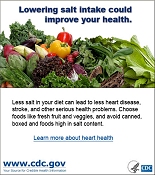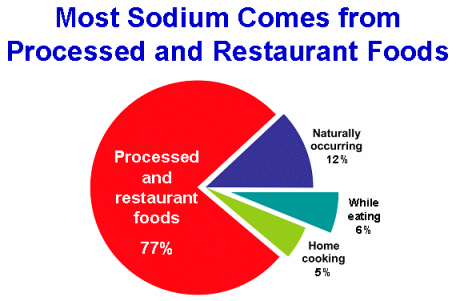 |
|
 |
 |
 |
Sodium
Most Americans Should Consume Less
Sodium
(1,500 mg/day or less)
Send a Sodium E-Card

|
Most of the sodium we consume is in the form of salt. Too much sodium is
bad for your health. It can increase your blood pressure and your risk for a
heart attack or stroke. Heart disease and
stroke are the first and third killers of men and women in the United
States each year.
Current dietary guidelines recommend that adults in general should
consume no more than 2,300 mg of sodium per day. However, if you are in the
following population groups, you should consume
no more than 1,500 mg per day.
- You are 40 years of age or older.
- You are African American.
- You have high blood pressure.
A new CDC report shows that two out of three (69%) adults in the United
States fall into these three groups who are at especially high risk for
health problems from consuming too much sodium. Eating less sodium can help prevent,
lower, or even control blood pressure.
Most of the sodium we eat comes from packaged, processed, store-bought, and
restaurants foods. Only about 5% comes from salt added during cooking and
about 6% comes from being added at the table. You can find out how much sodium you
are eating by checking the labels on food products and adding up the
sodium milligrams. If at a restaurant, ask for nutritional information
facts that include sodium.

Source: Mattes, RD, Donnelly, D. Relative contributions of dietary sodium
sources. Journal of the American College of Nutrition. 1991
Aug;10(4):383-393.
Choose a Heart-Healthy Diet
The DASH eating plan (Dietary Approaches to Stop Hypertension) is a
simple heart healthy diet that can help prevent or lower high blood
pressure.
This diet is LOW in sodium, cholesterol, saturated and total fat,
and HIGH in fruits and vegetables, fiber, potassium, and low-fat dairy products.
Making other lifestyle changes, like getting more physical activity,
while on the DASH eating plan gives you the biggest benefits. Click
here to learn more about the DASH Eating Plan.
CDC's Morbidity and Mortality Weekly Report on
Sodium
What You Can Do

To reduce your risk of heart disease and stroke—
- Know your
recommended limits for daily sodium intake.
- Choose
foods like fresh fruits and vegetables.
- Read the
nutrition label of the foods you purchase.
- Ask for
foods with no or low salt at restaurants.
|
Online Resources–Podcasts
- A Cup of Health with CDC
- Living a Less Salty Life
Hypertension, or high blood pressure, is a major risk factor for
heart disease and stroke. A diet high in sodium, or salt, can raise
blood pressure. Dr. Darwin Labarthe discusses the importance of
lowering your salt intake in order to minimize the risk of
developing hypertension.
Date released: 3/31/09
- A Minute of Health with CDC
- Living a Less Salty Life
A diet high in sodium can lead to high blood pressure, which is a
major risk factor for heart disease and stroke. This broadcast
discusses how people can improve their health by becoming aware of
the salt content in their food.
Date released: 3/31/09
Online Resources–Domestic
Online Resources—International
Return to Top of Page
*Links to non–Federal organizations are provided solely as a service to our users. Links do not constitute an endorsement of any organization by CDC or the Federal Government, and none should be inferred. The CDC is not responsible for the content of the individual organization Web pages found at this link.
Page last reviewed: March 22, 2009
Page last modified: April 7, 2009
Content source: Division for Heart Disease and Stroke
Prevention,
National Center for Chronic Disease Prevention and
Health Promotion |
 |